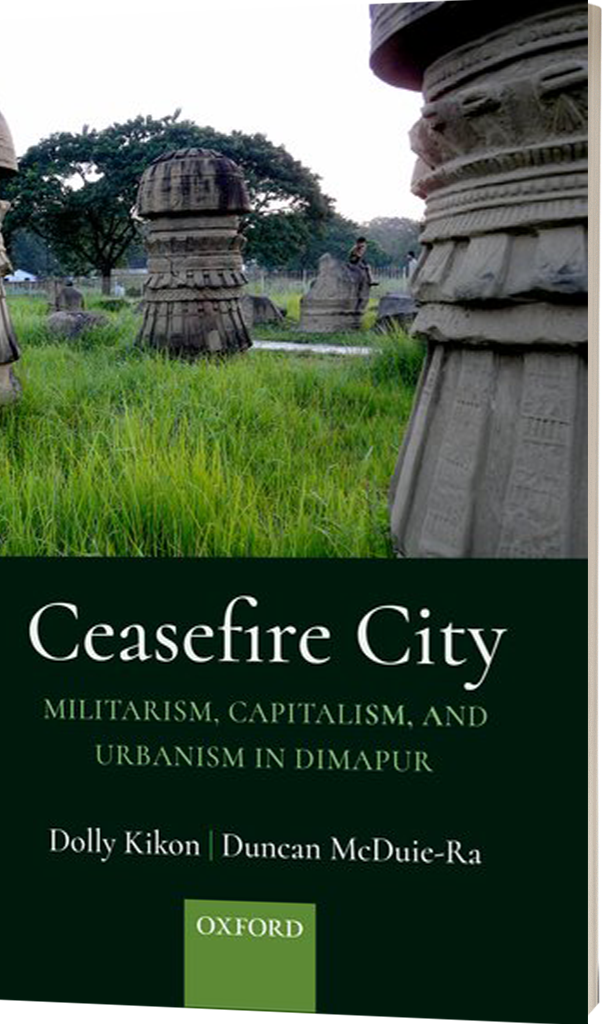Ceasefire City
Photo: Dolly Kikon
BOOKS
For a city in India’s northeast that has been embroiled in the everyday militarization and violence of Asia’s longest-running separatist conflict, Dimapur remains ‘off the map’. With no ‘glorious’ past or arenas where events of consequence to mainstream India have taken place, Dimapur’s essence is experienced in oral histories of events, visual archives of the everyday life, lived reality of military occupation, and anxieties produced in making urban space out of tribal space.
Ceasefire City aims to capture the dynamics of Dimapur by bringing together the fragmented sensibilities granted and contested in particular spaces in the city and the embodied experiences of the city by its residents. The first part of the book talks about military presence, capitalist growth, and urban expansion in Dimapur through an analysis of its spatial politics, and the second part, through collaborative ethnographic exercises, focuses on the relationship between the lived realities and the meanings that are forged around the city.

Ceasefire City
Militarism, Capitalism and Urbanism in Dimapur
Published 2021, Oxford University Press
Book Discussion
Reviews
Ceasefire City stands out amongst recent scholarship that has attempted to open the complexities of the process of territory formation through other small and medium towns…. Though the book appears to be about Dimapur, it also provides a wider context that helps comprehend comparable smaller cities that are often overlooked in scholarly discussions. The arguments and evidence presented in the book should be of interest to scholars invested in how urbanization works in non-metropolitan and non-capital cities…. [The book] delves deeper into the minute intricacies of urban transformation by examining how entirely new forms of place-making and a sense of belonging emerge alongside these factors…. [It] plays a vital role in dispelling and challenging preconceptions about Northeast India by putting the region’s complexity outside the prism of insurgency and moving beyond popular narratives focused on conflict and instability…. All in all, Ceasefire City is poised to leave a lasting impression. It will undoubtedly spur the creation of related works in the future. — Purba Barua, Birla Institute of Technology and Science
- [This book] critically contributes to the turn in scholarship that we have witnessed: a shift from studying megacities to small cities. Ceasefire City takes many imaginative leaps to understand the complex and contradictory yet routine rhythm of urbanism in a small frontier city in the Global South. The book presents a new way of reading the city through a multi-sensory methodological paradigm. – Ranu Kunwar, Australian National University
- [This book] creatively engages the complex ways in which ‘banal militarism’, that is ‘everydayness of militaristic displays of force and authority’, overlaps with capitalism and urban spatial order (p. 191). Kikon and McDuie-Ra have done a commendable job by capturing the subtle nuances in which these entail spatial order and disorder, pride and shame, hope and despair on the one hand, and the invariable ways in which they implicate urban futures in Dimapur and beyond. Given that ‘authentic’ Naga culture and identity is considered to start from where Dimapur ends, it may continue to be ‘off-the-map’ but not certainly in urban studies. In bringing back Dimapur ‘on-the-mental map’, Kikon and McDuie-Ra have invited us to imaginatively engage with the complex dynamics of place-making, belonging, inclusion/exclusion and multiple legal and political orders in a ceasefire city like Dimapur and beyond where militarism, capitalism, and urbanism thrive in conjunction. – Kham Khan Suan Hausing, University of Hyderabad
- An original perspective to an emerging city in the frontier that has evaded much of the attention of urban studies scholars…. What Kikon and McDuie-Ra find in Dimapur are contestations for control of the city, debates about the direction that urbanisation should take, and overlapping and sometimes coalescing forms of identity linked to living in a growing and connected urban city in a tribal state in North-east India, a city which hosts armed conflict and continues to be militarised. Kikon and McDuie-Ra’s Ceasefire City: Militarism, Capitalism and Urbanism in Dimapur is a valuable and significant contribution to understandings of cities, urbanisation and urban livelihoods in contexts that are marked by upheaval and disorder but that also contain hope and the promise of change. – Matthew Wilkinson, University of New South Wales
